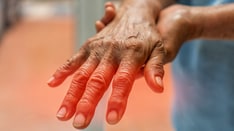TOPLINE:
An experimental skin blood flow measurement system shows promise in detecting early diabetic neuropathy (DN), offering a potentially low-cost, portable, and noninvasive diagnostic solution.
METHODOLOGY:
- The study included 15 nonsmoking individuals aged 18-60 years: two with DN, eight with diabetes mellitus (DM), and five control individuals.
- The study was conducted at Sri Ramachandra Medical College and Research Institute, Chennai, India. The study did not include the details of the race or ethnicity of participants.
- Vasoconstrictive (a lowered leg) and vasodilative (local heating) stimuli were applied to assess blood flow changes at the top of the foot.
- The blood flow index (BFI) values were recorded at the baseline and during stimulation using short-range diffuse optical correlation spectroscopy (DOCS) setup adapted to detect blood flow from shallow depths.
- BFI changes among groups were analyzed, employing receiver operating characteristics (ROC) curves and area under the curve (AUC) to evaluate the diagnostic potential of the DOCS system.
TAKEAWAY:
- In the control group, the BFI value showed a 33% decrease due to postural venoarteriolar reflex (VAR) in the lowered leg and a 140% increase due to local thermal hyperemia (LTH).
- In the DM group, BFI changes in response to stimuli were 9% and 53% for VAR and LTH, respectively, whereas the DN group showed minimal changes during VAR and LTH (< 5%).
- Significant differences in BFI values during LTH stimulus were noted between DN and DM groups and between DN and control groups (P < .0001).
- ROC analysis showed that LTH was more effective than VAR in distinguishing patients with DN from those with DM and control individuals based on AUC values.
IN PRACTICE:
The system "can be qualified as a potential candidate as a noninvasive, low-cost, portable, and continuous monitor in the early assessment of diabetic neuropathy," the authors wrote.
SOURCE:
The study was conducted by Vysakh Vasudevan and Sujatha Narayanan Unni, Department of Applied Mechanics and Biomedical Engineering, Indian Institute of Technology, Madras, Chennai, India. It was published online on December 20, 2023, in the Journal of Biophotonics.
LIMITATIONS:
The study's reliance on a small sample size potentially restricts the broader applicability of its findings.
DISCLOSURES:
The authors declared no conflicts of interest.




Comments